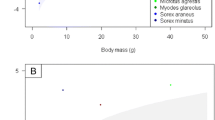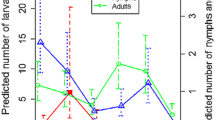Abstract
The underlying population dynamics and the behavioural patterns of the vectors are key issues in understanding the transmission of vector borne pathogens. For the tick Ixodes ricinus both seasonal and diel activity have been described as bimodal patterns, which in seasonal aspect has been interpreted as representing two cohorts. However, recent studies have shown that this interpretation may be incorrect. The aim of this study was to obtain more detailed information on nymph host seeking by studying subpopulations of ticks during the day and season. The study was designed to allow for comparisons of the diel variation and seasonal variation in their dependency in a number of tick characteristics. The study took place in a forest with planted beech trees without any undergrowth. Ticks were collected by flagging the dead leaves on the forest floor. For each nymph, a number of visual observations were made. The size and physiological age was observed and the nymphs were genotyped in the malate dehydrogenase locus (MDH, E.C. 1.1.1.37). Briefly the main results can be given as: (i) There were significant differences in the composition of size classes during the season, but only limited trends in time. (ii) The proportion of the small nymphs was highly variable, with a variation from 3% to 24% in October and September, respectively. (iii) The diel variation in MDH genotypes was significant in May and August. (iv) Nymph size classes and physiological age appeared to interact. The non-random interaction was caused by a relatively even distribution of small nymphs in all four age classes, while large nymphs tended to fall into age class 2 and 3. The length by age interaction for the individual months was noted to be significant in May, July, August and September, but not in June. Similarly the interaction was significant in the morning and afternoon, but not at midday. The overall results describe the seasonal and diel activity patterns as changing systematically for several characteristics under the influence of weather condition and population dynamics. In conclusion: The observations are best interpreted as being produced of a single cohort of ticks, but the revealed complexity of the host seeking activity suggest that measures of activity × abundance should be interpreted very cautiously in relation to population dynamics.
Similar content being viewed by others
References
Arthur D.R. 1962. Tick and Tick Disease. International Series of Monographs on Pure and Applied Biology. Vol. 9. Pergamon Press, Oxford.
Belozerov V.N. 1968. Photoperiodic control of seasonal development in ixodid ticks. Department of Medical Zoology, United States Naval Medical Research Unit. No.3, Cairo, Egypt, Translation 432 (T432).
Cody R.P. and Smith J.K. 1997. Applied Statistics and the SAS Programming Language, 4th ed. Prentice-Hall, Simon and Schuster, New Jersey, USA.
Gray J.S. 1985. Studies on the larval activity of the tick Ixodes ricinus L. in Co. Wicklow, Ireland. Exp. Appl. Acarol. 1: 307–316.
Gray J.S. 1987. Mating and behavioural diapause in Ixodes ricinus. L. Exp. Appl. Acarol. 3: 61–71.
Gray J.S. 1991. The development and seasonal activity of the tick Ixodes ricinus: a vector of Lyme borreliosis. Rev. Med. Vet. Entomol. 79: 232–333.
Jensen P.M. 2000. Seasonal activity of Ixodes ricinus ticks based on consecutive flagging. Exp. Appl. Acarol. 24: 695–708.
Jensen P.M., Kaufmann U. and Smirnova L. 1999. Diurnal activity of Ixodes ricinus in Denmark: Aspects of physiological age and genotypic variation. Hereditas 130: 325–330.
Kahl O. 1989. Untersuchungen ZumWasserhaushalt von Zecken (Acari: Ixodidae) Im laufe ihre postembyonalen entwicklung unter besonderer berücksichtigung der aktiven wasserdampfsorption bei gesoner stadien. Inaugural dissertation zur erhlangung der doktorgrades des fachbereiches biologie der freien Universität Berlin.
Krebs C. 1999. Ecological Methodology. Addison-Wesley Educational Publishers, Benjamin Cummings, California, USA, 79–84.
Lees A.D. 1946. The water balance in Ixodes ricinus L. and certain other species of ticks. Parasitology 37: 3–20.
Lees A.D. 1948. The sensory physiology of the sheep tick, Ixodes ricinus L. J. Exp. Biol. 25: 145–207.
Lees A.D. and Milne A. 1951. The seasonal and diurnal activities of individual sheep ticks (Ixodes ricinus L.). Parasitology 41: 189–208.
McLeod J. 1934. Ixodes ricinus in relation to its physical environment: the influence of climate on development. Parasitology 26: 282–305.
McLeod J. 1936. Ixodes ricinus in relation to its physical environment, IV an analysis of the ecological complexities controlling distribution and activities. Parasitology 28: 295–319.
Mejon H.A. 1998. Diel activity of Ixodes ricinus Acari: Ixodidae at two locations near Stockholm, Sweden. Exp. Appl. Acarol. 21: 247–255.
Needham G.R. and Teel P.D. 1991. Off-host physiological ecology of Ixodid ticks. Ann. Rev. Entomol. 36: 659–681.
Randolph S. 2002. An Empirical quantitative framework for the seasonal population dynamics of the tick Ixodes ricinus. Int. J. Parasitol. 32: 979–989.
Rechav Y. 1979. Migration and dispersal patterns of three African ticks (Acari: Ixodidae) under field conditions. J. Med. Entomol. 16: 150–163.
Rechav Y. and Fielden L.J. 1995. The effect of host resistance on the metabolic rate of engorged females of Rhipicephalus evertsi evertsi. Med. Vet. Entomol. 9: 289–292.
Rechav Y., Manango S.R. and Fielden L.J. 1994. The effects of tick numbers and intervals between infestations on the resistance aquired by guinea-pigs to adults of Rhipicephalus evertsi evertsi (Acari: Ixodidae). Exp. Appl. Acarol. 18: 735–745.
Schmidt-Nielsen K. 1984. Scaling: Why is Animal Size So Important. Cambridge University Press, USA, 56–73.
Sonenshine D.E. 1991. Biology of Ticks, Vol. 1 and 2. Oxford University Press, New York, pp. 101–104.
Thingstrup I. and Rosendahl S. 1994. Quantification of fungal activity in arbuscular mycorrhizial symbiosis by polyacrylamide gel electrophoresis and densiometry of malate dehydrogenase. Soil. Biol. Biochem. 26: 1483–1489.
Uspensky I. 1995. Physiological age of Ixodid ticks: aspects of its determination and application. J. Med. Entomol. 32: 751–764.
Van Es R.P., Gettingby G. and Hillerton E. 1999. Models of temporal variation in questing activity in individuals of Ixodes ricinus (Acari: Ixodidae). Exp. Appl. Acarol. 23: 977–986.
Wiliams J.P., Sauer J.R., McNew R.W. and Hair J.A. 1986. Physiological and biochemical changes in unfed Lone Star ticks, Amblyomma americanum (Acari: Ixodidae) with increasing age. J. Med. Entomol. 23: 230–235.
Author information
Authors and Affiliations
Corresponding author
Rights and permissions
About this article
Cite this article
Jensen, P., Kaufmann, U. Seasonal and diel activity of Ixodes ricinus (Acari: Ixodidae) subpopulations in Denmark. Aspects of size, physiological age, and malate dehydrogenase genotype in a forest site without any undergrowth. Exp Appl Acarol 30, 289–303 (2003). https://doi.org/10.1023/B:APPA.0000006515.66461.32
Issue Date:
DOI: https://doi.org/10.1023/B:APPA.0000006515.66461.32




